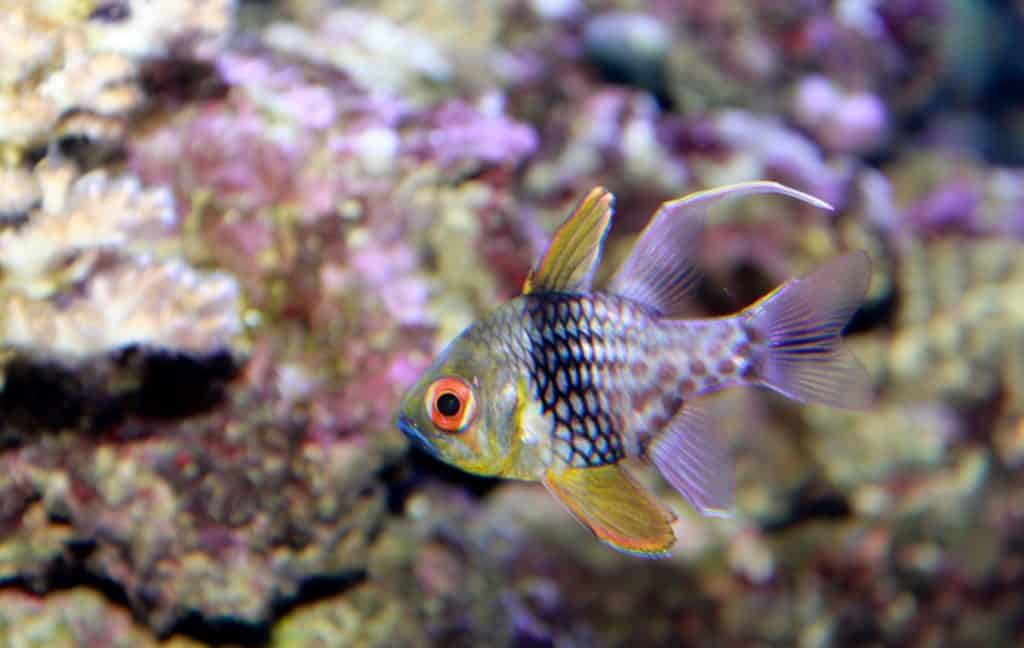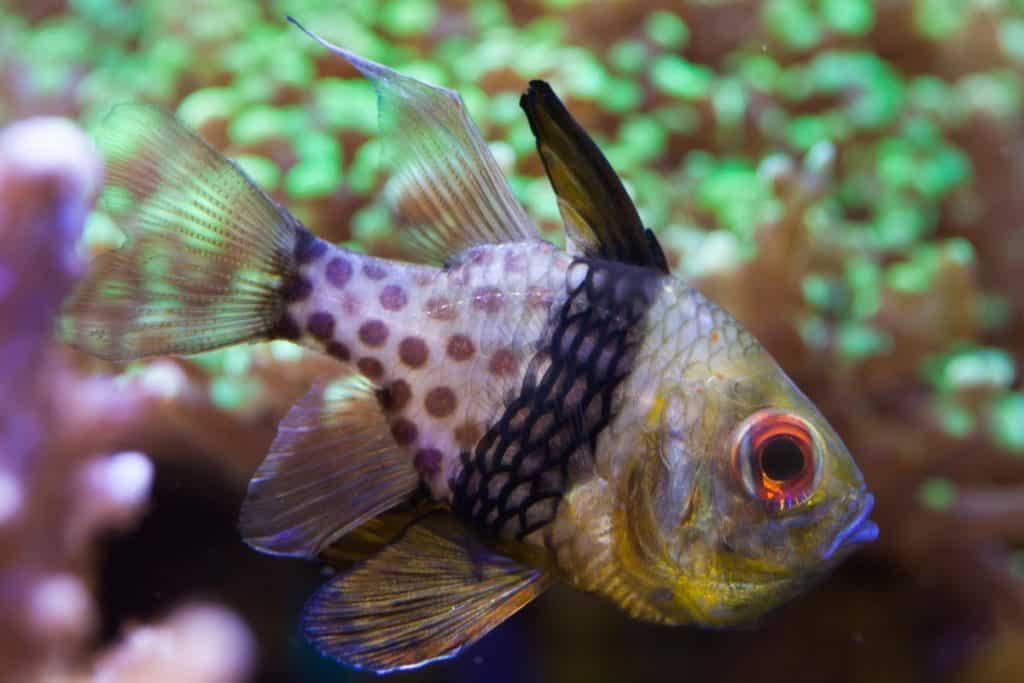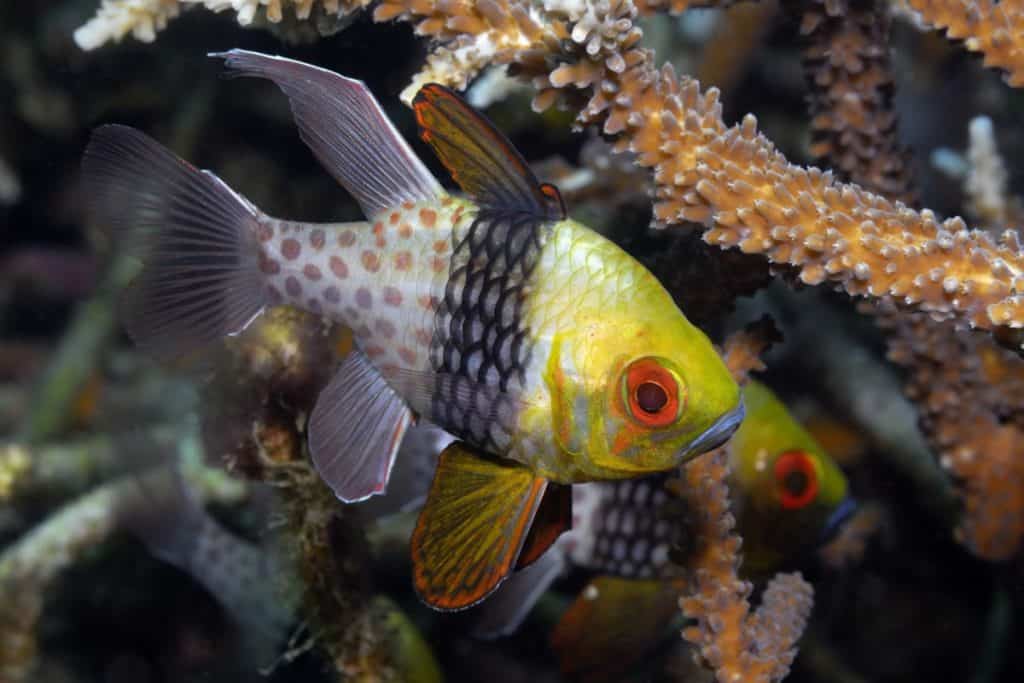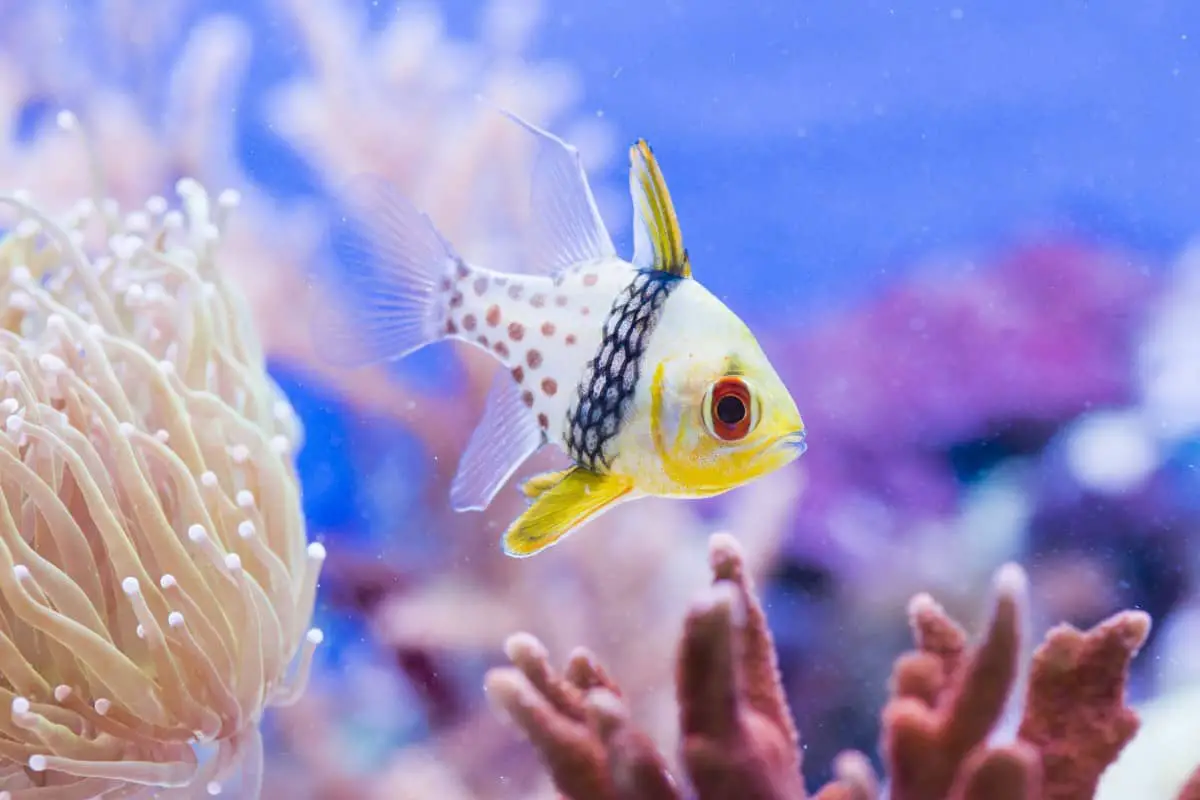Have you ever come across a species of fish that has you setting up an aquarium dedicated just to them? I have, and I think you will be surprised when I tell you which species it is. Why? Because it is not a fish that you would instantly think of as needing an aquarium all of their own; it is not your typical species only!
Without further ado, the species I am talking about is the small and peaceful, yet charismatic Pajama Cardinalfish. I told you you’d be surprised. However, read on and I’m sure you’ll be falling in love with the spotted cardinalfish which is what many people call this fish.
Pajama Cardinalfish (sphaeramia nematoptera) complete care guide.
Table of Contents
Pajama Cardinal:Species Profile
At little more than three inches in size and with their timid personalities the Pajama Cardinalfish may not come across as either particularly needing nor deserving an aquarium all of their own. They are naturally quiet and shy, tend to favor hanging out in the shadows; they don’t come across as the most exciting of fish!
The truth is, however, that under the right conditions, a species only aquarium, sphaeramia nematoptera will be a happy, sociable, and friendly species that can be encouraged to become more diurnal.
They are also gorgeous in appearance with their crazy coloration and patterns, a sight to behold hovering in their aquarium in large groups.Care wise, and this is a real bonus, the pajama Cardinalfish requires nothing more than adequate space, the correct diet, and somewhere shaded and dim to hang out. They truly are the poster child for beginner saltwater fish. They are also relatively easy to breed in the home aquarium making them a great project to pursue.
| Scientific Name | Sphaeramia nematoptera |
|---|---|
| Common Names | Pajama Cardinalfish, rainbow Cardinal |
| Family | Apogonidae |
| Temperament | Peaceful |
| Care Level | Easy |
| Diet | Carnivore |
| Reef Safe | Yes |
| Max Size | 3.5-4" |
| Water Conditions | 72-79° F, dKH 8-12, pH 8.1-8.5, sg 1.020-1.024 |
| Tank Size | 20 Gallons + |
| Origins | Captive bred - Fiji, Indonesia, Sri Lanka |
| Breeding | Mouth Brooder |
| Recommended first fish | Yes |
| Best Foods | Live foods-brine shrimp,copepods,mysis shrimp. Also flake, pellet and frozen foods. |
| Jumpers | Yes, when first introduced keep a lid on the tank. |
| Tank Level | Mid-Top |
| Lifespan | 4 plus years |
| Desirability | Medium |
| Our Star rating | 4.5 out of 5 |
| Cost | $15 |
Pajama Cardinalfish appearance and difference in males and females
It’s probably fair to say that the Pajama Cardinalfish is not what you would call a traditionally attractive species. Rather it is quirky, unique, and completely unforgettable. This, of course, was not the intention of Mother Nature when she created the Pajama Cardinal; more likely, she wanted to make it camouflage.

This may seem like a crazy claim with a species that displays a rainbow of colors. After all the Pajama Cardinalfish has a greenish yellow face, leading to a black band down the middle.
This is followed by a silver-colored posterior covered in an orange polka dot. Hardly the most conspicuous of fish, especially when you add in the bright orange eyes!
The truth is, however, that once amongst sea urchins the Pajama Cardinalfish can become hidden. The black band blends them in amongst the sea urchins spines, whilst the posterior dotted with orange spots merge with marine scape coloration.The Pajama Cardinalfish is a very manageable size for a home aquarium reaching no more than three inches. They, like other members of the Apogonidae family, have two distinct dorsal fins with the broader and more transparent having a long trailing filament.
Where do Pajama cardinalfish come from?
The Pajama Cardinalfish ( sphaeramia nematoptera )is found throughout much of the Western Pacific Ocean. Its range goes from Java to Fiji, and the Ryukyu Islands to the Great Barrier Reef. The natural population is believed to be of low vulnerability meaning they are thriving fairly well.
Being nocturnal, by day the Pajama Cardinalfish form large hierarchical groups among the rocky crevices in sheltered lagoons and bays. By night, they disperse from their hiding places in search of small crustaceans which make up the majority of their diet.Interestingly, though the Pajama Cardinalfish is nocturnal, they dwell in shallow waters from 3 to 50 feet in depth. This may be why they seek the shade and darkness of rocky crevices and ledges. Though they are mainly found in groups there, occasional solitary pairs can be spotted too.

Are Pajama Cardinalfish aggressive?
The Pajama Cardinalfish is a very social species that enjoy being and will thrive best when kept in small groups. These groups are usually run in a hierarchical way with the largest male taking control of the group.
Dominance is not achieved by aggression; this species is not an aggressive one. They may, however, get into minor scuffles between themselves involving fin flicking, chasing and nudging. It is rare, however, that these ‘run-ins’ result in any injury.
Whether captive bred or wild caught the Pajama Cardinalfish will be most active during the nighttime darker hours. They are inherently nocturnal, and will mainly be seen swimming and feeding at this time. These species are slow but steady swimmers, very enjoyable to watch.
During the day, most Pajama Cardinalfish will be found hovering in one place. This place is usually beneath a rocky overhang in the shade, or near to a coral or cave.

Some, however, will get used to being more diurnal, especially if fed during this time. The Pajama Cardinalfish is very food orientated and can be tempted into the light with a meaty treat.
You may also have more luck achieving diurnal Pajama Cardinalfish if your marine aquarium has few to no predators. This species is timid around more aggressive and boisterous fish and will hide to avoid them.
That is not to say the Pajama Cardinalfish doesn’t have some predatory instincts itself as it does. Ornamental shrimp and other invertebrates that move within its reach will all be on this species menu.
How to care for a Sphaeramia nematoptera
If you are looking for a marine fish species that is suitable for a beginner to the marine aquarium hobby, the Pajama Cardinalfish is ideal. They are hardy, have no special requirements, and are extremely easy to care for; overall a novices dream.
Aquarium wise, the Pajama Cardinalfish, requires at least 20 gallons for a single specimen. This, however, a solitary life, is not ideal for this rather social fish. Rather, they would prefer and thrive better in a group of five plus in a 30 to 40 gallons, or eight in 100 gallons plus.
Decor-wise, Pajama Cardinalfish need plenty of rocky overhangs, caves, corals, and if possible sea anemones to hang around during the day. They also love seagrass if you can provide them with some. Filtration needs to be of a high standard with brisk water movement provided. Though they are a hardy species and can be forgiving of less than perfect water parameters, aquarium maintenance should not be neglected.
Lighting, if possible, should be minimal and low to allow for the best viewing opportunities. Where this is not possible, however, as previously stated you can encourage, with some degree of success, the Pajama Cardinalfish to become more diurnal. This is done by offering food, which this species is driven by, through daylight hours.
When choosing Pajama Cardinalfish it is of great import that you ensure the specimens you pick are healthy so that you do not introduce any diseases or parasites to your aquarium. Healthy specimens will display vigorous eating habits, have clear eyes, and their fins will all be intact and undamaged.
Of course, it is not always easy to tell that the fish you are purchasing is completely healthy and disease free, so quarantine for a period of around two weeks is a good idea. This is not an essential part of adding Pajama Cardinalfish to your aquarium but it can help avoid future health issues.
Introducing your fish to their new home
When adding the spotted cardinalfish to a quarantine aquarium, or their permanent home it is also essential to acclimate them. This can be done using one of two methods; drip acclimation which is usually used for less hardy, more sensitive species, and the floating method which is used for more hardy species such as Cardinalfish.
In order to acclimate your fish using the floating method simply follow these steps:
1. Turn off the aquarium lights and any lights in the room. Bright light can stress or traumatize fish that have been in the darkness of their packaging.
2. Place the bag containing your fish into the aquarium and let it float for around fifteen minutes.
3. Open the bag and roll the lip down allowing the bag to be floated in your aquarium whilst open.
4. Add ½ cup of aquarium water.
5. Repeat step four every five minutes until the floating bag is full of water and then discard half.
6. Repeat step 4 and 5 before netting the Pajama Cardinalfish and adding it to the aquarium.
7. Dispose of the water left in the bag. Do not add this water to the aquarium.
Common illness and disease
Though clearly, the pajama Cardinalfish is fairly hardy and, as previously stated, fairly forgiving of less than perfect aquarium conditions, it does not mean that they are immune to sickness. Rather, they are just as susceptible as other fish to common health issues such as fin rot or marine ich.
What do Pajama Cardinalfish eat?
Pajama Cardinalfish are carnivorous nocturnal feeders that feast upon small crustaceans in their natural habitat. In captivity, they require a similar meaty diet that is varied and nutritious and will fulfill all their dietary requirements.
Foods that you can feed your Pajama Cardinalfish include vitamin-enriched brine shrimp, Mysis shrimp, feeder shrimp, marine flesh, frozen meaty foods, and high-quality flake and pellet. These should be offered 2 to 3 times a day with at least one feeding being at night.
Please note that feeding a high-quality diet will not only ensure your Pajama Cardinalfish are fit and healthy, but can also help keep their bright coloration, and improve fertility and the number of viable hatching larvae.
We highly recommend feeding them a staple saltwater dried fish food like Tetra Marine Flake in conjunction with a variety of foods to ensure they receive a mixed and varied diet.
We also feed our fish veggie seaweed sticks which all the fish love to pick at. We hold ours in place with a plastic aquarium food click like the one in the picture. But overall I think they love brine shrimp more than anything.
How to sex and Breed Sphaeramia nematoptera
As with many species of fish, it is not possible to tell a male from a female Pajama Cardinalfish definitively. Indicators of sex, however, are that the male is generally slightly larger with a longer secondary dorsal fin; whilst the female has a fuller, rounded body than that of the male. Males also brood the eggs and have large swollen jaws during this time, making them easy to spot.
The majority of spawnings between Pajama Cardinalfish take place at night making them hard to view. Usually, the first sign that spawning has indeed taken place, is the male having a swollen jaw. Spawnings will be regular and easy between mated pairs.
The male will carry the eggs for between three and four weeks during which time he will not feed. The female’s job during this time is to protect both the male and the eggs. She will do this with extreme aggression, remaining with the male until the fry are released.
Resulting and surviving fry, males may eat their first few broods, can be fed with a turkey baster on baby brine shrimp until they are large enough to feed on their own. Removal of the male from the main aquarium to a breeding tank, once he is brooding, is advisable. This will help ensure that other aquarium inhabitants cannot feed on the fry and make it easier for you to feed them.
Suitable tank mates
Due to the Pajama Cardinalfish being timid it is not advisable to house them with larger and more aggressive tank mates. Rather, they should be kept with species that are as peaceful as themselves. Seahorses and Pipefish can make ideal aquarium companions, as can filefish, Clownfish, Dwarf Angelfish, Dragonets, Gobies, and Wrasses.
Potential tankmates for pajama cardinals could also include Damsels, Parrotfish, and Pseudochromis. You should, however, have a backup plan if placing these species together, in case things do not work out.
Conclusion: Pajama Cardinalfish Care Guide
It’s always great when you come across a fish species, like the Pajama Cardinalfish, that is so easy to keep, and yet so appealing. This is especially true when that species is marine; which when compared to freshwater is reputedly hard to keep. It is both a joy and a pleasure to discover these fish and bring them directly to you.
[author title=”About the Author”]

I have been working in the tropical fish industry for over 30 years now and I’m still learning. Everyday is a school day in this hobby. In my spare time I play golf very badly!


